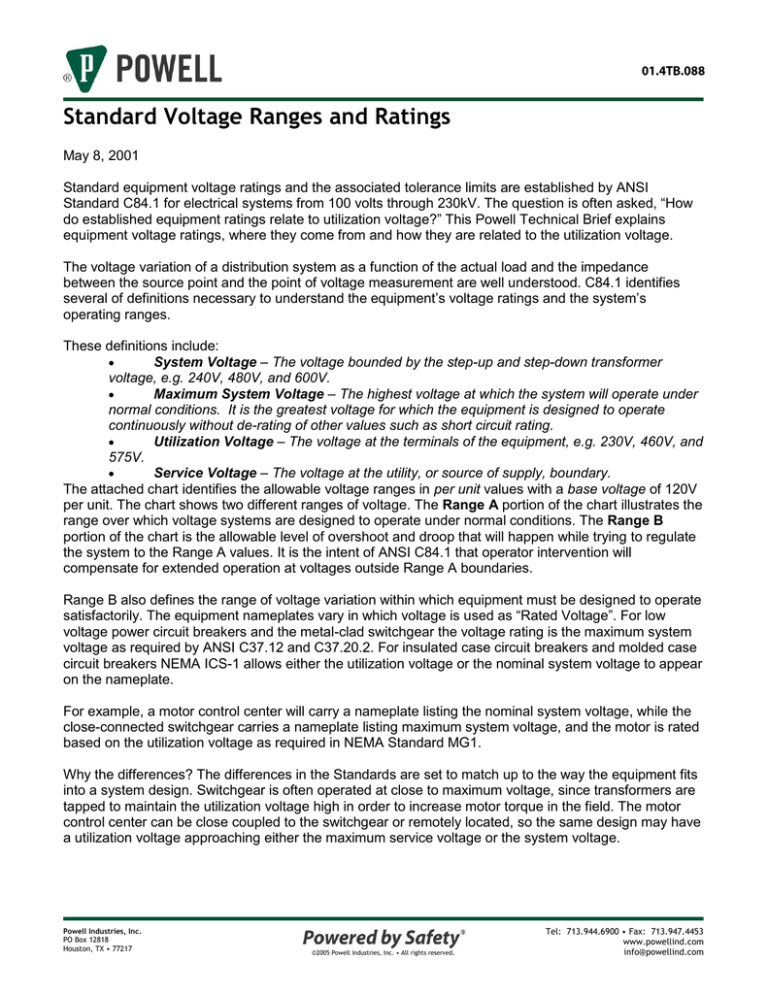
Standard Voltage Ranges and Ratings
May 8, 2001
Standard equipment voltage ratings and the associated tolerance limits are established by ANSI
Standard C84.1 for electrical systems from 100 volts through 230kV. The question is often asked, “How
do established equipment ratings relate to utilization voltage?” This Powell Technical Brief explains
equipment voltage ratings, where they come from and how they are related to the utilization voltage.
The voltage variation of a distribution system as a function of the actual load and the impedance
between the source point and the point of voltage measurement are well understood. C84.1 identifies
several of definitions necessary to understand the equipment’s voltage ratings and the system’s
operating ranges.
These definitions include:
System Voltage – The voltage bounded by the step-up and step-down transformer
voltage, e.g. 240V, 480V, and 600V.
Maximum System Voltage – The highest voltage at which the system will operate under
normal conditions. It is the greatest voltage for which the equipment is designed to operate
continuously without de-rating of other values such as short circuit rating.
Utilization Voltage – The voltage at the terminals of the equipment, e.g. 230V, 460V, and
575V.
Service Voltage – The voltage at the utility, or source of supply, boundary.
The attached chart identifies the allowable voltage ranges in per unit values with a base voltage of 120V
per unit. The chart shows two different ranges of voltage. The Range A portion of the chart illustrates the
range over which voltage systems are designed to operate under normal conditions. The Range B
portion of the chart is the allowable level of overshoot and droop that will happen while trying to regulate
the system to the Range A values. It is the intent of ANSI C84.1 that operator intervention will
compensate for extended operation at voltages outside Range A boundaries.
Range B also defines the range of voltage variation within which equipment must be designed to operate
satisfactorily. The equipment nameplates vary in which voltage is used as “Rated Voltage”. For low
voltage power circuit breakers and the metal-clad switchgear the voltage rating is the maximum system
voltage as required by ANSI C37.12 and C37.20.2. For insulated case circuit breakers and molded case
circuit breakers NEMA ICS-1 allows either the utilization voltage or the nominal system voltage to appear
on the nameplate.
For example, a motor control center will carry a nameplate listing the nominal system voltage, while the
close-connected switchgear carries a nameplate listing maximum system voltage, and the motor is rated
based on the utilization voltage as required in NEMA Standard MG1.
Why the differences? The differences in the Standards are set to match up to the way the equipment fits
into a system design. Switchgear is often operated at close to maximum voltage, since transformers are
tapped to maintain the utilization voltage high in order to increase motor torque in the field. The motor
control center can be close coupled to the switchgear or remotely located, so the same design may have
a utilization voltage approaching either the maximum service voltage or the system voltage.
Powell Industries, Inc.
PO Box 12818
Houston, TX • 77217
©2005 Powell Industries, Inc. • All rights reserved.
Tel: 713.944.6900 • Fax: 713.947.4453
www.powellind.com
info@powellind.com
Standard Voltage Ranges and Ratings
page 2
An example of how the chart works:
For a 480V system the maximum voltage will be proportional to the new systems nominal system voltage
by the ratio of the maximum per unit voltage (127 per unit) to the nominal voltage (120 per unit).
X
Maximum Voltage Rating =
127 per unit
=
480
120 per unit
Maximum Voltage Rating for 480V is 508V.
Powell Industries, Inc.
PO Box 12818
Houston, TX • 77217
©2005 Powell Industries, Inc. • All rights reserved.
Tel: 713.944.6900 • Fax: 713.947.4453
www.powellind.com
info@powellind.com
Standard Voltage Ranges and Ratings
page 3
Therefore, the 508V will appear on the nameplate of the low voltage power circuit breaker as the
maximum voltage. The motor control center will list the system voltage of 480V. The motors connected
to the motor control center will list the utilization voltage of 460V.
The difference between minimum service and minimum utilization voltages is the intended voltage drop
within the wiring system. This difference is greater for services greater than that of 600Vac which allows
for a transformer voltage drop between service voltage and utilization equipment.
The Range B utilization voltage limits for 6900Vac and 13800Vac are 90% and 110% of the voltage
rating of the standard motor and thus vary slightly from the chart.
I hope this helps to clarify the different voltage ratings. Please do not hesitate to contact me if I can be of
further help.
Jim Bowen
Technical Director
Powell Industries, Inc.
PO Box 12818
Houston, TX • 77217
©2005 Powell Industries, Inc. • All rights reserved.
Tel: 713.944.6900 • Fax: 713.947.4453
www.powellind.com
info@powellind.com


